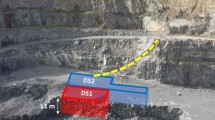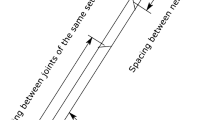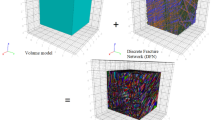Abstract
There are important potential engineering applications of a prediction model for rock mass block size distribution from linear fracture frequency measurements along scanlines on exposed rock walls along diamond drill cores, or along digitized borehole walls. These pertain to the characterization of rock masses in mining and geotechnical engineering projects either using rock mass classification systems or empirical equations for the reduction of rock mass parameters or numerical simulation codes. Another application is the resource estimation of decorative stone deposits using diamond drill coring or image analysis of borehole walls. In these cases, the resources are derived from the distribution of rock block volumes greater than a certain cut-off volume. It could be realized that such a prediction could lead apart from the evaluation of the measured decorative stone resources, also to the optimization of pit limits and the final estimation of proven reserves. Further, it could lead to optimization of block volume diamond wire cuts at the later stage of squaring of block volumes by comparing the final distribution after squaring with the original in situ block size distribution. Towards this aim and based on the results of a previous paper, we further elaborate: (a) on the composition of the method to characterize the fracture frequencies observed along diamond drill cores and (b) on the analytical prediction of the block volume distribution. Analytical model predictions are finally validated against actual production data from a white dolomitic marble quarry and they are compared with predictions of a more rigorous numerical simulation model based on a non-homogeneous Poisson process.








Similar content being viewed by others
Abbreviations
- bvp:
-
Block volume proportion
- cdf:
-
Cumulative distribution function
- CBVP:
-
Cumulative block volume proportion
- DFN:
-
Discrete fracture networks
- FF:
-
Fracture frequency (m−1)
- \(f_{\lambda }\) :
-
Number of fractures per fixed length interval along scanline or rock core (m−1)
- f(v) :
-
pdf of rock block volumes v
- \(F(v)\) :
-
cdf of rock block volumes
- GSI:
-
Geological strength index
- HPP:
-
Homogeneous Poisson process
- JS:
-
Joint spacing (m)
- J v :
-
Volumetric joint count (m−3)
- NHPP:
-
Non-homogeneous Poisson process
- pdf:
-
Probability density function
- RMR:
-
Rock mass rating
- RV:
-
Random variable
- x :
-
Sampling length (or sample support) (m)
- \(P\left\{ {V \le v} \right\}\) :
-
Probability that a volume V will be less than a given volume v
- \(B\left( {k,m} \right)\) :
-
Beta function
- \(\Gamma \left( \cdot \right)\) :
-
Gamma function
- \(\lambda\) :
-
Basic linear frequency parameter of the negative exponential pdf (m−1)
- \(\hat{\lambda }\) :
-
Apparent linear frequency parameter of the negative exponential pdf (m−1)
- \(\psi (x)\) :
-
Euler’s psi function
- \(\psi^{(n)} (x)\) :
-
n-th Derivative of the psi function
References
Bateman H (1953) Higher transcendental functions, I edn. McGraw-Hill Book Company Inc, New York
Cai M, Kaiser PK, Uno H, Tasaka Y, Minami M (2004) Estimation of rock mass strength and deformation modulus of jointed hard rock masses using the GSI system. Int J Rock Mech Min Sci 41(1):3–19
Elmo D, Rogers S, Stead D, Eberhardt E (2014) Discrete fracture network approach to characterise rock mass fragmentation and implications for geomechanical upscaling. Mining Technol 123(3):149–161
Elmouttie MK, Poropat GV (2012) A method to estimate in situ block size distribution. Rock Mech Rock Eng 45:401–407
Gradshteyn IS, Ryzhik IM (1980) Table of integrals, series, and products. Academic Press Inc, Cambridge
Hudson JA, Priest D (1979) Discontinuities and rock mass geometry. Int J Rock Mech Min Sci 16:339–362
Hudson JA, Priest D (1983) Discontinuity frequency in rock masses. Int J Rock Mech Min Sci 20(2):73–89
Jern M (2004) Technical note: determination of the in situ block size distribution in fractured rock, an approach for comparing in situ rock with rock sieve analysis. Rock Mech Rock Eng 37(5):391–401
Kim BH, Cai M, Kaiser PK, Yang HS (2007) Estimation of block sizes for rock masses with non-persistent joints. Rock Mech Rock Eng 40(2):169–192
Latham J-P, Van Meulen J, Dupray S (2006) Prediction of in situ block size distributions with reference to armour stone for breakwaters. Eng Geol 86:18–36
Laubscher DH (1993) Planning mass mining operations. In: Hudson JA (ed) Comprehensive rock engineering, principles, practice and projects, analysis and design methods, Vol. 2 Pergamon Press, Oxford, pp 547–583
Miles RE (1972) The random division of space. In: Advances in applied probability, supplement: Proceedings of the symposium on statistical and probabilistic problems in metallurgy 4: 243–266
Miyoshi T, Elmoa D, Rogers S (2018) Influence of data analysis when exploiting DFN model representation in the application of rock mass classification systems. J Rock Mech Geotech Eng 10:1046–1062
Palmström A (2001) Measurement and characterization of rock mass jointing. In: Sharma VK, Saxena KR (eds) In situ characterization of rocks. A. A. Balkema, Rotterdam, pp 49–97
Papoulis A (1984) Probability, random variables, and stochastic processes, 2nd edn. McGraw Hill, New York
Priest SD (1993) Discontinuity analysis for rock engineering. Stephen Chapman & Hall.
Priest D, Hudson JA (1976) Discontinuity spacings in rock. Int J Rock Mech Min Sci 13:135–148
Priest D, Hudson JA (1981) Estimation of discontinuity spacing and trace length using scanline surveys. Int J Rock Mech Min Sci 18:183–197
Rocscience software products DIPS (2012) Roc-plane. Rocscience Inc., Toronto
Rogers SF, Kennard DK, Dershowitz WS, Van As A (2007) Characterising the in situ fragmentation of a fractured rock mass using a discrete fracture network approach. In: Eberhardt, Stead and Morrison (eds) Rock mechanics: meeting society’s challenges and demands, Taylor & Francis Group, London
Ross SM (1993) Intoduction to probability models, 5th edn. Academic Press, New York
Stavropoulou M (2014) Discontinuity frequency and block volume distribution in rock masses. Int J Rock Mech Min Sci 65:62–74
Stavropoulou M, Saratsis G, Xiroudakis G, Exadaktylos G (2019) Estimation of fracture spacings distribution from fracture counts along drill cores. Probabilistic Eng Mech (under review)
Wang H, Latham JP, Poole AB (1990) In-situ block size assessment from discontinuity spacing data. Proceedings of the 6th Congress of the IAEG, Amsterdam, August 6–10, Symposium, vol. 117–127, Balkema, Rotterdam.
Wang LG, Yamashita S, Sugimoto F, Pan C, Tan G (2003) A Methodology for predicting the in situ size and shape distribution of rock blocks. Rock Mech Rock Eng 36(2):121–142
Young DS, Boontun A, Stone CA (1995) Sensitivity tests on rock block size distribution. In: Daemen and Schultz (eds) Rock mechanics, Balkema, Rotterdam
Author information
Authors and Affiliations
Corresponding author
Additional information
Publisher's Note
Springer Nature remains neutral with regard to jurisdictional claims in published maps and institutional affiliations.
Appendices
Appendix A
Correction of Joint Orientation Bias
The true spacing \(d\) between two adjacent joints of the same set assumed to be parallel to each other could be found from the apparent spacing \(\hat{d}\) using the acute angle \(\theta\) subtended between the normal to the joint planes and the borehole axis (Fig.
9)
If the borehole is vertical, then the angle \(\theta\) is simply the dip angle of discontinuity, otherwise \(\cos \theta\) is determined from the scalar product of the unit vector \({\text{n}}\) directed normal to the joint planes of a set and of the vector \({\text{m}}\) directed along the borehole in the following manner:
wherein bold small case letters denote vectors and \(\left| {\; \cdot \;} \right|\) denotes the length of the vector it encloses. It is recalled that the unit normal vector of a plane of the i-th joint set with dip angle \(\alpha_{i}\) and dip direction angle \(\beta_{i}\) is defined as an 1 × 3 array as follows:
From the above expression and assuming a right-handed Cartesian coordinate system Oxyz the cosine factor may be derived as follows:
The unit vector of the borehole axis with trend \(\beta\) and plunge \(\alpha\) is defined as
Substituting Eqs. (A.3) and (A.5) into Eq. (A.2) it is found
Block Face Area and Block Volume Calculation
The two parallel sides of the six-sided parallelepiped rock block shown in Fig.
10 belong to the joint set 3 and they are formed by the intersection of the two parallel planes of discontinuity set 1 with true spacing \(d_{1}\) and the two planes of discontinuity 2 with true spacing \(d_{2}\). Then the area of each face of the same block corresponding to joint set 3 could be found as follows:
where \(d_{23} ,\;d_{13}\) denote the lengths of the edges formed by the intersections of planes 2,3 and 1,3, respectively, \(\hat{d}_{1} ,\;\hat{d}_{2}\) are the apparent spacings of consecutive joints of sets 1,2, respectively, measured along the borehole, and \(\theta_{1}^{{}} ,\;\theta_{2}\) are the acute angles subtended between the normal vectors to the joint planes 1, 2, respectively and the borehole axis.
The apparent frequencies \(\hat{\lambda }_{i} ,\;i = 1,2,3\) of the pdf’s of each joint set inferred along a set of boreholes may be used to find the product of the basic joint frequencies that is used in the volume distribution function [i.e. Eq. (4)], as follows:
The angle \(\theta_{12}\) formed between joint planes 1 and 2 is found from the vector product of the vectors of the edges formed by the intersection of planes 1 and 3 and of planes 2 and 3 in the following fashion:
with \({\text{n}}_{{{13}}}\), \({\text{n}}_{{{23}}}\) denoting the vectors of parallelogram edges and \({\text{n}}_{{3}}\) the unit normal vector of plane 3 defined by Eq. (A.3).The edge vectors \({\text{n}}_{{{13}}}\),\({\text{n}}_{{{23}}}\) may be found from the vector product of the respective unit normal vectors of three joint planes (side 13 belongs to plane 1 and 3 and side 23 belongs to 2 and 3) in the following manner:
where the normal unit vectors on the joint planes are found by recourse to Eq. (A.3).
Also the angles \(\theta_{13}\) and \(\theta_{23}\) can be found from the following scalar products:
In a final step of calculations performed in the Excel worksheet “Volume”, the volume of a block created from three repeated discontinuity sets is found by multiplying the area of the face given by Eq. (A.7) with the true distance (or spacing) between consecutive joints of the set 3, i.e.
where here the orientation correction factor denoted with the symbol cf is defined as follows:
By virtue of Eqs. (A.12) and (A.13), the apparent frequencies \(\hat{\lambda }_{i} ,\;i = 1,2,3\) of the pdf’s of each joint set inferred along the boreholes may be employed for the calculation of the product of the basic joint frequencies, as follows:
Rights and permissions
About this article
Cite this article
Stavropoulou, M., Xiroudakis, G. Fracture Frequency and Block Volume Distribution in Rock Masses. Rock Mech Rock Eng 53, 4673–4689 (2020). https://doi.org/10.1007/s00603-020-02172-6
Received:
Accepted:
Published:
Issue Date:
DOI: https://doi.org/10.1007/s00603-020-02172-6






